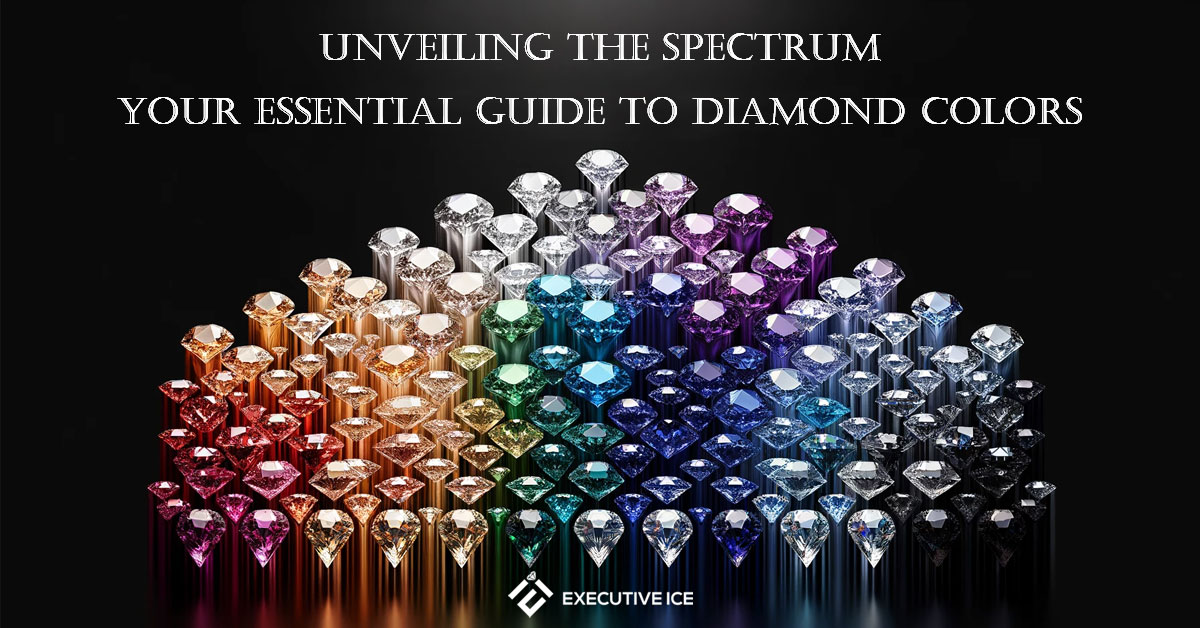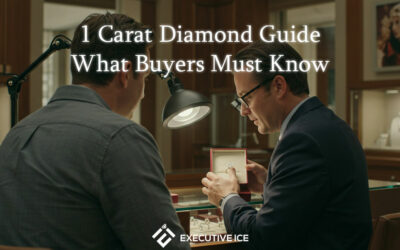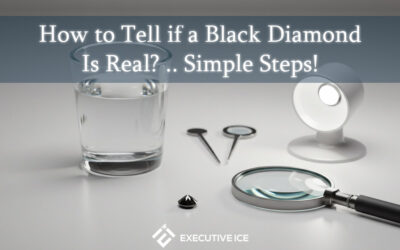Have you ever marveled at the beauty of a diamond and wondered what makes it so captivating? Well, a big part of that allure comes from its color. In the world of diamonds, color plays a mighty role, and it’s not just about the traditional white sparkle we all know and love.
When we talk about the color in diamonds, we’re diving into a spectrum that ranges from crystal clear to subtle shades. It’s like looking at a sky full of stars; each one shines differently. In diamonds, even the slightest hint of color can make a big difference in its personality and value.
Traditionally, the most sought-after diamonds are those that are colorless, like a drop of pure water. These gems are prized for their ability to reflect light beautifully, creating that dazzling sparkle that diamonds are famous for. But here’s where it gets interesting – not all diamonds are colorless. In fact, diamonds come in a rainbow of colors, each with its own unique charm.
The color of a diamond isn’t just a matter of appearance; it’s a story about its journey from deep within the Earth. It tells us about the conditions it was formed in, the elements it was exposed to, and the journey it took to reach us.
In this guide, we’ll explore the fascinating world of diamond colors. We’ll talk about what influences the color of a diamond, how it’s graded, and how these hues affect its value. Whether you’re a fan of the classic colorless sparkle or drawn to the unique beauty of colored diamonds, there’s a whole world of color waiting to be discovered.
So, let’s jump in and uncover the secrets of diamond colors – it’s a journey that’s as colorful as it is enlightening!
1. Introduction
-
Explanation of What Diamond Colors Is
When you think of diamonds, you might picture those dazzling, crystal-clear gems. But in reality, diamonds come in a whole palette of colors, and understanding this is key to appreciating their beauty.
So, what is diamond color? It’s about the natural tint that a diamond has. Most diamonds, especially those we use in jewelry, have some degree of color. This color usually ranges from colorless, like a drop of pure water, to a light yellow or brown shade. These subtle differences in color are natural and come from the conditions under which the diamond formed deep in the Earth.
The presence of color in a diamond is mostly due to the trace elements that were around when the diamond was forming. For example, a tiny bit of nitrogen can give a diamond a yellowish tint. It’s like how a pinch of seasoning can change the flavor of a dish.
But here’s something interesting – not all colored diamonds are seen the same way. While most people love the classic colorless look, some diamonds are valued for their distinct colors. We’re talking about fancy colored diamonds here, like pinks, blues, and even greens. These are pretty rare and are colored by different elements and conditions than your typical yellow or brown tints.
Understanding diamond color is all about seeing the beauty in these differences. It’s like appreciating the different colors in a sunset. Each shade tells a story, and each diamond’s color is a whisper of its journey from deep inside the Earth to your jewelry box.
So, as we explore more about diamond colors, remember – each color is a natural work of art, making every diamond unique in its own way. Stay tuned as we dive deeper into this colorful world!
2. Understanding Diamond Colors
-
Introduction to the Color Grading System
This system is like a map that helps us navigate through the world of diamond colors, understanding what makes each one special.
Now, in the diamond world, color grading is a big deal. It’s how we figure out where a diamond stands in the color spectrum – from totally colorless to having a noticeable hue. Think of it like the leaves in fall; some are bright and clear, while others have rich, deep colors.
The color grading system we use today was developed by the Gemological Institute of America (GIA). They created a scale that starts at D and goes all the way to Z. This might seem a bit backward, but there’s a reason for it. Before this system, diamond color grading was all over the place, with terms like ‘A’ or ‘AA’ being used without consistency. The GIA wanted to start fresh, so they began their scale at D to avoid any confusion.
In this guide, we’ll take a closer look at this color grading system, what each grade means, and how it can help you find the diamond that sings to your heart. So, stick around, and let’s dive deeper into the colorful world of diamonds!
-
How Diamond Color is Assessed and Graded
Now, let’s get into how experts look at a diamond and decide what color grade to give it. It’s a bit like being a judge in a dance competition, except here, they’re judging how a diamond shows its colors.
When professionals grade a diamond’s color, they’re looking at how much color the diamond shows. This isn’t about fancy colors like blues or pinks, but mostly the shades ranging from colorless to yellow or brown. It’s a subtle art and takes a keen eye.
The process starts with comparing the diamond to a set of master stones. These master stones are a set of diamonds with known color grades, kind of like a set of color swatches you’d use to pick out paint. The diamond being graded is viewed under controlled lighting and compared against these master stones to see where it fits on the color scale.
As mentioned above, this scale, created by the Gemological Institute of America (GIA), goes from D to Z. A ‘D’ grade means the diamond is totally colorless, like a drop of mountain spring water. As you move down the scale, the diamond shows more color, reaching ‘Z’, which has a noticeable light yellow or brown tint.
It’s important to note that this grading is done in a lab under specific lighting conditions. This is because the color can look different under different lights. It’s like how the color of the sky changes from noon to dusk.
Another thing – the grading is usually done with the diamond facing down. This might seem odd, but it’s the best way to see the true color without any sparkle or facets getting in the way.
So, when you hear about a diamond’s color grade, remember, it’s been given by folks who have trained their eyes to spot these subtle differences. They help us understand the shade of the diamond, guiding us to find the one that speaks to our hearts.
That’s the gist of how diamond color is assessed and graded. It’s a blend of science and art, ensuring each diamond is given the grade that best describes its natural hue.
3. The Diamond Color Grading Scale
-
Detailed Breakdown of the Color Grading Scale (D-Z)
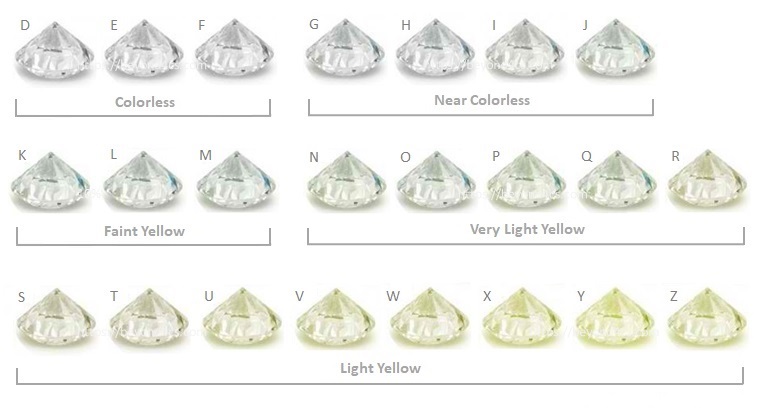
Reference:- beyond4cs.com
Alright, let’s take a closer look at this color grading scale that ranges from D all the way to Z. Imagine this scale as a path through a forest, where the scenery changes subtly as you walk from one end to the other.
-
D-F (Colorless):
These diamonds are like a clear, untouched sky. They’re the most rare and sought after because they don’t have any color at all. They’re the epitome of purity and brilliance in the diamond world.
-
G-J (Near Colorless):
Now, we’re stepping into a zone where there’s just a hint of color, but it’s hard to see with the naked eye, especially when the diamond is set in jewelry. These diamonds offer a good balance between lack of color and value.
-
K-M (Faint Color):
Here, the path leads us to diamonds with a slight color that can be seen more easily. This color is usually a pale yellow. These diamonds can still be beautiful, especially if you like a warmer tone.
-
N-R (Very Light Color):
The color gets a bit more noticeable in this range. The diamonds have a clear yellow or brown tint. They’re less commonly used in fine jewelry but can have a unique appeal.
-
S-Z (Light Color):
At this point, the color is quite obvious. These diamonds have a distinct yellow or brown hue. While not as traditionally valued as the colorless stones, they can still be beautiful and have a unique charm.
But here’s the thing – color isn’t just about ranking or price. It’s about personality. Some folks love the traditional, icy sparkle of a colorless diamond, while others fall for the warm charm of a diamond with a touch of color.
It’s important to remember that this scale is about subtlety. The differences between each grade, especially in the higher grades, can be hard to see unless you’re trained or using the right tools.
So, when you’re looking at diamonds, keep in mind that each letter in this scale represents a step in the diamond’s color journey. From the pure, icy clarity of D to the warm, gentle hues of Z, each grade tells a story of light and color.
That’s our color grading scale, a map that guides us through the diverse and beautiful world of diamond colors. Whether you love the classic, colorless sparkle or the unique warmth of a tinted diamond, there’s a place for everyone in this colorful forest.
4. Factors Affecting Diamond Color
-
How Impurities and Chemical Composition Influence Color
When we’re talking about what gives a diamond its color, we’re really talking about the story of its life deep down in the Earth. It’s like a tale of its journey from underground to jewelry stores like James Allen and Blue Nile store.
Now, diamonds are made of carbon, right? But sometimes, during their formation, other elements sneak in there too. These ‘impurities’ can change the color of the diamond. It’s like adding a splash of paint to a clear glass of water.
-
Nitrogen:
The most common guest at the diamond party is nitrogen. Even a tiny bit of nitrogen can give a diamond a yellowish color. It’s like a pinch of spice changing the flavor of a dish.
-
Boron:
If Boron joins the mix, you might end up with a blue diamond. These are pretty rare and quite a sight to see, like a clear sky on a sunny day.
-
Pressure and Heat:
Sometimes, it’s not just about what’s in the diamond, but what it’s been through. Extreme pressure and heat can twist and stretch the diamond’s structure, affecting how light passes through it. This can create fancy colors like pink, red, or even green.
It’s fascinating how these tiny changes can create various colors. It’s like nature’s own art project, using just carbon, a few stray elements, and a whole lot of pressure and heat.
So, when you look at a colored diamond, remember, you’re not just looking at a gemstone. You’re looking at the result of millions of years of Earth’s work, a little chemistry, and a lot of natural magic. It’s the story of the Earth, written in a language of light and color.
-
The Impact of Shape and Cut on Perceived Color
Alright, let’s talk about how a diamond’s shape and cut can play a trick on our eyes when it comes to color. You see, it’s not just what’s inside the diamond that counts; it’s also how it’s shaped and cut.
-
Shape of the Diamond:
Different shapes can highlight or hide a diamond’s color. Some shapes, like the round brilliant cut, are really good at disguising color. They reflect so much light that it’s harder to notice any yellow hues. It’s like a sunny day where the sunlight makes everything look bright. But other shapes, like emerald or asscher cuts, have wide, open facets that can make the color more noticeable. It’s like a calm pond that lets you see right into the water.
-
Cut Quality:
Now, the quality of the cut is another big player. A well-cut diamond can make the color look more uniform and balanced. A high-quality cut creates lots of sparkle and brilliance, which can distract the eye from any color tints. It’s like a skilled dancer who knows how to move so gracefully that you can’t help but be captivated.
For more about diamond cut, you can explore our Beginner’s Guide to Diamond Cut Perfection.
-
Facet Arrangement:
The way the facets (those little flat surfaces on a diamond) are arranged also has a big impact. Some cuts are designed to maximize brightness and sparkle, which can make the diamond appear whiter. It’s like having a bunch of tiny mirrors reflecting light in the best possible way.
So, when you’re looking at diamonds, remember that the shape and cut are doing a little dance with the color. They can either bring it into the spotlight or help it blend into the background. It’s a delicate balance, like painting a picture or composing a song, where every little part works together to create something beautiful.
That’s the scoop on how the shape and cut of a diamond can influence how we perceive its color. It’s all part of the art and science that goes into making each diamond a unique piece of nature’s artwork.
5. Choosing the Right Color for Your Diamond
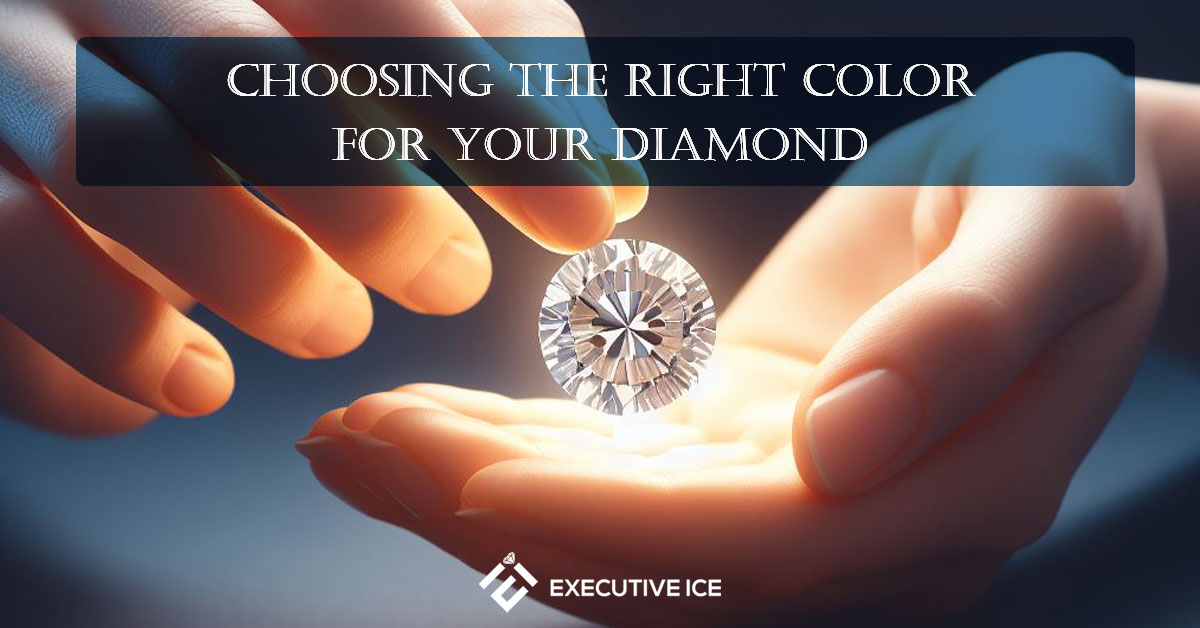
-
Tips on Selecting the Right Color Based on Setting and Style
Let’s get into how you can pick the perfect diamond color that fits your setting and style. It’s like matching the right colors in your outfit to make sure everything looks just right.
-
Consider the Metal of the Setting:
The color of the metal in your setting can make a big difference. If you’re going for a white gold or platinum setting, you might want a diamond with less color (like in the D-G range) because these metals can make any yellowish tint more noticeable. It’s like wearing a white shirt; it makes bright colors really pop. But if you’re leaning towards yellow or rose gold, you can go with a diamond that has a bit more color (like in the H-K range) since these metals are warmer and can complement the diamond’s natural hue.
-
Think About the Style of the Jewelry:
The style of the piece also plays a big role. If you have a vintage or antique design, a diamond with a slight yellow tint can add to that warm, classic feel. It’s like adding a touch of sepia to a photograph to give it an old-timey look. On the other hand, for modern and minimalist designs, you might prefer a colorless or near-colorless diamond to keep things crisp and clean.
-
Match With Personal Style:
Your personal style should guide your choice too. If you love bold and unique pieces, a diamond with a distinct color or even a fancy-colored diamond could be a great fit. It’s all about what makes you feel good and matches your personality. Like choosing the colors you wear, picking a diamond color is about expressing yourself.
-
Lighting Matters:
Remember, diamonds can look different in various lighting. A color that looks one way in the store might look different in natural light. It’s a good idea to check out the diamond under different lights to make sure you love the color all the time.
Choosing the right color for your diamond is about finding that sweet spot where the gem’s natural beauty meets your personal style and the setting it’ll live in. It’s a bit like finding harmony in a song, where every note is in the right place. With these tips in mind, you can find a diamond that sings to you in just the right key.
-
Balancing Color Grade with Other Factors (Cut, Clarity, and Carat)
When you’re out there picking a diamond, it’s like balancing on a log across a creek. You gotta consider not just the color, but also the cut, clarity, and carat. Here’s how you can keep your balance:
-
Cut and Color:
The cut of a diamond can influence how its color appears. A well-cut diamond, especially in shapes that reflect more light like the round brilliant, can make the color less noticeable. It’s like a good dance move that grabs all the attention – you might not notice the dancer’s outfit as much.
-
Clarity and Color:
Clarity refers to how many blemishes or inclusions (that’s internal features) a diamond has. Sometimes, a diamond’s sparkle from a good cut can draw your eye away from both color and clarity imperfections. It’s like focusing on the melody of a song so much that you don’t notice a small mistake in the lyrics.
-
Carat and Color:
Carat is about the weight (and generally the size) of the diamond. Larger diamonds tend to show color more easily than smaller ones. So, if you’re going big, you might want to aim higher on the color scale. It’s like painting a big room; flaws in the paint job are more noticeable than in a small room.
-
Overall Balance:
The key is to find the right combination for your taste and budget. Maybe you prefer a larger diamond with a bit of color or a smaller one that’s nearly colorless. It’s all about what looks right to your eye and feels right in your heart.
Remember, each diamond is unique, just like every one of us. Balancing color with cut, clarity, and carat is about finding the diamond that tells your story, the one that connects with you on all levels. So, take your time, weigh these factors, and you’ll find a diamond that’s just as special as your own journey.
6. The Role of Color in Diamond Pricing
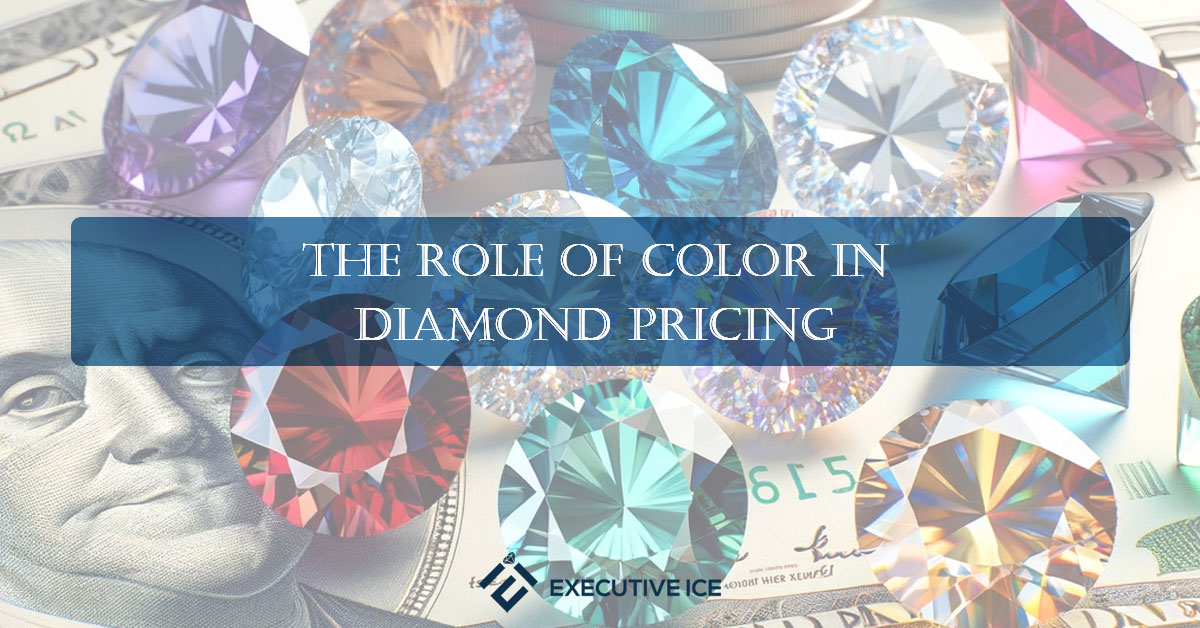
-
How Color Grade Affects the Value of a Diamond
Let’s dive into how the color of a diamond plays a big role in its price tag. It’s like figuring out the value of a piece of art; the details really matter.
In the diamond world, the closer to colorless, the higher the price tends to be. Diamonds graded D, E, or F, which are colorless, are like rare treasures. They’re hard to find, so they fetch a higher price. It’s like spotting an eagle in the sky; it’s a rare and exciting sight, so it’s valued more.
As you move down the scale to G, H, I, and J (near colorless), the price starts to drop a bit. These diamonds might have a slight hint of color, but it’s usually not noticeable to the untrained eye. They offer a sweet spot for many folks – beautiful diamonds that don’t break the bank. It’s like finding a beautiful view that’s a bit off the beaten path.
Once you hit K and beyond, where the color becomes more noticeable, the price tends to be lower. But here’s the thing – some people really love the warmer look of these diamonds. They have a charm all their own, like a cozy campfire.
And don’t forget about fancy colored diamonds – like pinks, blues, and yellows. These are a different story. Their value depends on how intense and unique their color is. Some of these, like a deep blue or a vibrant pink, can be worth a lot, sometimes even more than a colorless diamond. It’s like finding a rare flower in the wilderness.
So, when you’re thinking about diamond color and price, remember it’s all about what you love and what feels right for you. Whether you go for the icy sparkle of a colorless diamond or the warm glow of a tinted one, each has its own value and beauty, just like each one of us has our own path to walk in this world.
-
Comparing Prices Across Different Color Grades
So, you’re curious about how the price changes as you wander through the different color grades of diamonds? Well, let’s paint a picture of this landscape.
Imagine you’re walking through a market, and each stall has diamonds of a different color grade. As you start at the D color grade stall, the most colorless and pure, you’ll notice these are the most prized and have the highest price tags. It’s like finding the finest handmade crafts; they’re special and rare.
As you move along to the G to J color grades, the prices become a bit more friendly. These diamonds have just a whisper of color, often unnoticeable unless you’re really looking for it. Here, you’re getting something beautiful without spending as much. It’s like finding a gorgeous handmade item that’s a little more within reach.
When you reach the K to M grades, where the color is more apparent, the prices are usually lower. But remember, these diamonds have their own kind of warmth and character. Some folks might find a diamond here that speaks to them more than the higher-priced ones. It’s like finding a piece of art that catches your eye, and it just happens to be more affordable.
Now, if you venture into the fancy-colored diamond area, things get different. These aren’t graded on the D-Z scale. Their price depends on how rare and vivid the color is. A rich, deep blue or an intense pink can command very high prices, sometimes even higher than the colorless ones. It’s like coming across a rare and unique piece that catches everyone’s attention.
So, as you’re comparing prices across different color grades, it’s like exploring different booths at a market. Each has its own charm and value, and the right one for you is a balance of what catches your eye, feels right in your heart, and fits in your budget. It’s all about finding that perfect gem that tells your story.
7. Fancy Colored Diamonds
-
Overview of Fancy Colored Diamonds (e.g., Pink, Blue, Yellow)
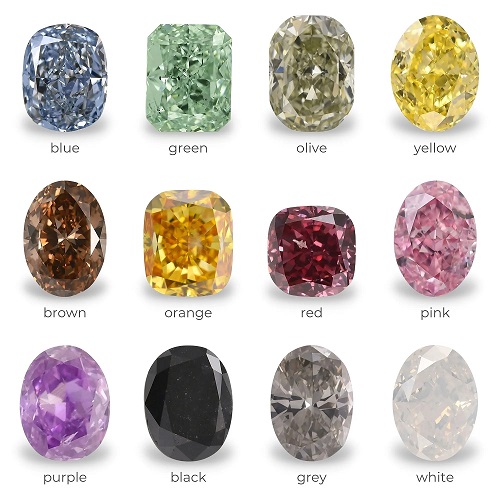
Reference:- leibish.com
Let’s talk about a real eye-catching part of the diamond world – fancy-colored diamonds. These aren’t your everyday diamonds; they’re like the rare birds of the gemstone forest, showing off colors that are truly out of the ordinary.
-
First up, Pink Diamonds:
These beauties are like the dawn sky, with shades ranging from delicate blush to rich raspberry. Pink diamonds get their color from a twist in their structure as they form. They’re pretty rare and sought after, making them a favorite for those looking for something truly unique.
-
Blue Diamonds:
Then, there’s the blue diamonds. They’ve got a touch of magic, like the deepest parts of the ocean. Their color comes from boron trapped in the structure of the diamond. The famous Hope Diamond is one of these blue wonders – a true treasure of nature.
-
Yellow Diamonds:
Yellow diamonds are like little drops of sunshine. Their cheerful hue comes from nitrogen in their makeup. These diamonds range from pale lemon to deep gold, and they have a bright, vibrant feel that’s hard to miss.
Fancy-colored diamonds come in other colors too, like green, orange, and even rare reds. Each color has its own story, depending on the elements present and the conditions when the diamond was formed.
These colored diamonds are graded a bit differently than the usual white ones. It’s not about being colorless but about the intensity and quality of the color. The more vivid and pure the color, the more valuable the diamond.
So, when you’re looking at fancy-colored diamonds, you’re stepping into a world of rare beauty. Each color is a glimpse into the deep, mysterious processes of the Earth, and owning one is like holding a piece of that mystery in your hand. Whether it’s the gentle pink, the deep blue, or the sunny yellow, each fancy-colored diamond is a unique piece of Earth’s art.
-
How They Differ from Regular Color Grading
How these fancy-colored diamonds are graded, which is quite different from your regular white diamond grading. It’s like comparing the judging of a vibrant painting to a classic black-and-white photograph.
As mentioned above, in the regular diamond world, we grade based on how colorless a diamond is, with D being totally colorless and Z showing noticeable color. But when it comes to fancy-colored diamonds, it’s a whole different story. Here, the game is all about the color’s intensity, purity, and rarity.
-
Intensity:
The grading of fancy-colored diamonds focuses on how strong or intense the color is. The scale ranges from faint to vivid, with vivid being the most prized. It’s like looking at a sunset; the more intense and deep the colors, the more breathtaking it is.
-
Color Purity:
Another important factor is how pure or true the color is. A fancy-colored diamond that shows a strong, singular color is often more valuable than one with mixed hues. It’s like a clear, bright blue sky being more striking than one that’s partly cloudy.
-
Rarity:
The rarity of the color also plays a big part in grading. Some colors, like red and blue, are super rare in diamonds, so they’re especially valuable. It’s like finding a rare bird or flower; the rarer it is, the more special it becomes.
So, when it comes to fancy-colored diamonds, it’s not about looking for the lack of color. It’s about celebrating the presence and beauty of color. These diamonds are like nature’s rare artworks, each with its own unique palette and story. They stand apart from the regular grading system, shining in their own colorful way.
8. Care and Maintenance of Colored Diamonds
-
Tips for Maintaining the Color and Brilliance of Your Diamond
Caring for colored diamonds is like tending to a precious garden. You want to keep them looking as beautiful as the day you got them. Here’s how you can do just that:
-
Regular Cleaning:
Just like any diamond, colored diamonds need regular cleaning to keep their sparkle. (More details in the next section).
-
Avoid Harsh Chemicals:
Harsh chemicals can be rough on colored diamonds. Avoid exposing your diamonds to chlorine, bleach, and other harsh chemicals found in cleaning products or pools. It’s like protecting a delicate flower from strong winds.
-
Professional Check-ups:
Regular visits to a professional jeweler can help ensure that the settings are secure and the diamond isn’t at risk of damage. They can also give your diamond a thorough, safe cleaning and check for any color changes.
-
Best Practices for Cleaning and Storing Colored Diamonds
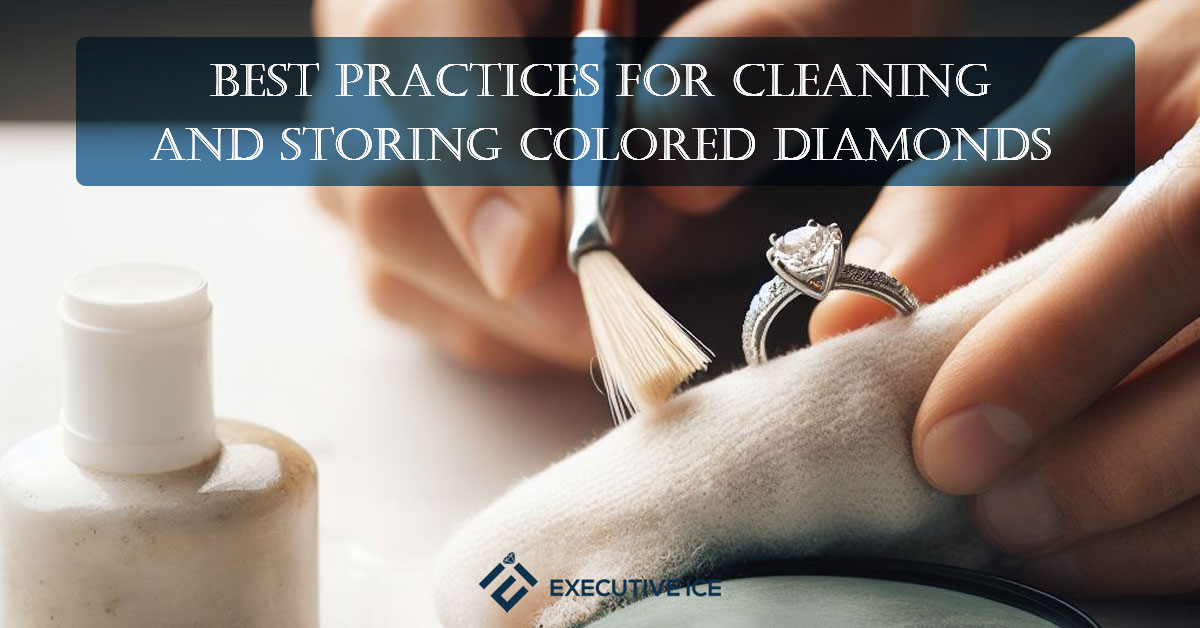
Let’s talk about keeping those colored diamonds in tip-top shape, making sure they keep shining just like the first day.
-
Cleaning Colored Diamonds:
○ Gentle Cleaning Solutions: Mix a bit of mild dish soap with warm water. Colored diamonds, like all precious stones, prefer a soft touch.
○ Soft Brush: Use a soft-bristled brush – think like a baby’s toothbrush – for gentle scrubbing. This helps to get rid of any dirt without being too rough on the stone.
○ Rinse Thoroughly: Make sure to rinse off any soap residue under lukewarm water. It’s like washing off a leaf so it can breathe and shine in the sun.
○ Pat Dry: Gently pat your diamond dry with a soft, lint-free cloth. It’s like drying off a butterfly’s wings – gentle and careful.
-
Storing Colored Diamonds:
○ Separate Storage: Store your colored diamonds separately from other jewelry. They can scratch each other, and we sure don’t want that.
○ Fabric-Lined Boxes: Use a fabric-lined jewelry box or individual soft pouches. Think of it as tucking them into their own little beds, safe and sound.
○ Avoid Extreme Temperatures: Keep them away from too much heat or cold. Extreme temperatures can be tough on colored diamonds.
○ Away from Direct Sunlight: Just like how direct sunlight can fade the colors of a painting, it can sometimes affect the color of your diamonds, especially the lighter or more vibrant ones.
By following these simple steps, you’re making sure your colored diamonds stay as beautiful as the day they chose you. It’s all about giving them a little care and attention, so they can keep sharing their colors and stories with you for many years to come.
9. FAQs about Diamond Color
-
Addressing Common Questions and Misconceptions
Let’s clear up some of the common questions and misconceptions about diamond color. It’s always good to have the right info, just like having a map when you’re on a trail.
-
Is a colorless diamond always better?
Not necessarily. While colorless diamonds are traditionally prized for their purity and brilliance, the ‘best’ color is really about personal preference. Some folks love the unique warmth of a slightly colored diamond. It’s like choosing between a sunny day and a cozy, golden sunset – both are beautiful in their own way.
-
Can you easily see the color in lower-grade diamonds?
It depends. In grades D to J, the color differences can be quite subtle and hard to notice without comparing them side by side under proper lighting. Once you get to K and beyond, the color becomes more noticeable. It’s like the difference between a light and a deep shade of a color.
-
Do colored diamonds sparkle less?
Not at all! The sparkle of a diamond depends more on its cut than its color. A well-cut diamond, regardless of its color, can have a beautiful sparkle. It’s like a good fire – it doesn’t matter what wood you use; if it’s well-tended, it’ll still crackle and dance.
-
Are all yellow or brown diamonds considered low quality?
Nope. While higher grades on the color scale are colorless, yellow or brown diamonds can be stunning, too. Plus, fancy colored diamonds like intense yellows or pinks are highly valued for their unique beauty. It’s about embracing the diversity of colors in the diamond family.
-
Do fancy-colored diamonds follow the same grading system as white diamonds?
They have their own system. Fancy-colored diamonds are graded based on the intensity and purity of their color, not on their lack of color like white diamonds. It’s a whole different ball game, celebrating the beauty of color in all its glory.
Remember, when it comes to diamond color, it’s all about what you love and what speaks to you. Each diamond color has its own charm and story, just like each one of us. So, trust your heart when you choose – it knows your true colors.
10. Conclusion
-
Summary of Key Points about Diamond Color
Well, friends, we’ve taken a good walk through the colorful world of diamonds. Let’s sit back and reflect on what we’ve learned about diamond color.
Color Grades Matter: We talked about the color grading scale from D to Z, where D is colorless and Z has noticeable color. Remember, the grade affects the diamond’s value and look, but the ‘best’ color is really up to your personal taste and style.
The Beauty of Fancy Colors: We explored the vibrant realm of fancy colored diamonds – pinks, blues, yellows, and more. These aren’t graded on the same scale as white diamonds; their value comes from the intensity and rarity of their color.
Personal Preference is Key: Whether you prefer the icy sparkle of a colorless diamond or the warm charm of a colored one, it’s all about what speaks to you. Diamonds come in all colors, each with its own story and beauty.
Care and Maintenance: We discussed how to care for colored diamonds, emphasizing gentle cleaning and careful storage. Keeping your diamonds away from harsh chemicals and direct sunlight helps maintain their color and brilliance.
Common Misconceptions: Finally, we cleared up some misconceptions, like the idea that colorless diamonds are always better, or colored diamonds don’t sparkle. Remember, every diamond, regardless of its color, has its own unique sparkle and charm.
In the end, choosing a diamond is like choosing a companion for your journey. It’s about finding the one that resonates with your spirit and adds a bit of sparkle to your story. Whether it’s colorless or colored, each diamond has its own way of shining.
So, there you have it – a whirlwind tour of diamond colors. I hope this guide helps you find the diamond that not only catches your eye but also captures your heart.
-
Final Thoughts and Advice for Diamond Buyers
As we come to the end of our journey through the world of diamond colors, I want to share a few parting words – some wisdom to carry with you as you venture out to find your perfect diamond.
Trust Your Eyes and Heart: When it comes to choosing a diamond, your own eyes and heart are your best guides. Don’t get too caught up in the technicalities. Choose a diamond that speaks to you, one that you feel a connection with. It’s like choosing a path to walk; trust your instincts.
Balance is Key: Remember, it’s all about finding the right balance between the color grade and other factors like cut, clarity, and carat. Don’t focus on just one aspect; consider how they all come together to create a diamond that fits your desires and budget.
Embrace the Unique: Every diamond has its own personality, its own story. Whether it’s colorless or colored, each has its own form of beauty. Embrace the uniqueness of each stone and remember that it’s these differences that make them special.
Educate Yourself: The more you know, the better your choice will be. Take some time to learn about diamonds, their grading, and what makes each one special. It’s like learning the language of the land – it helps you understand and appreciate it more.
Seek Trusted Sources: Finally, always buy diamonds from reputable and trusted sources. Look for sellers who provide detailed information about their diamonds and who are willing to answer your questions like James Allen and Blue Nile. It’s like finding a guide for your journey – you want someone knowledgeable and trustworthy.
So, there you have it, some final nuggets of wisdom as you go in search of your diamond. Remember, a diamond is more than just a stone; it’s a piece of the Earth’s story and, now, a part of yours. Happy diamond hunting, and may you find the one that lights up your world!

